Brief

Until recently, there was almost unanimous consensus within the truck industry that the days of premium import trucks in China were numbered. With joint ventures expected to grow stronger and domestic brands closing the quality gap, even the most enthusiastic proponents of European import trucks in China foresaw only narrow niche applications in the premium segment.
However, recent research by Bain & Company1 into the preferences of China’s truck buyers, owners and fleet managers paints a different picture, one that is more optimistic about the prospects for European premium brands in China. While Europe’s truck makers will need to invest in several new capabilities and find some smart ways to overcome challenges before they can fully capitalize on new opportunities, our findings warrant a fresh look at China’s market.
First, our research finds China’s truck market moving up, with more than 20% of buyers planning to upgrade to a higher-value product segment with their next truck purchase (see Figure 1). Most plan to upgrade within domestic or JV brands, boosting the newly emerging upper-middle segment, which we expect to grow significantly over the next few years. However, about one in five of those looking to upgrade want to buy a European import truck, which could double the premium segment by 2022. Almost three-quarters of those expecting to upgrade plan to do so within the next one to three years, creating a sizable near-term opportunity.
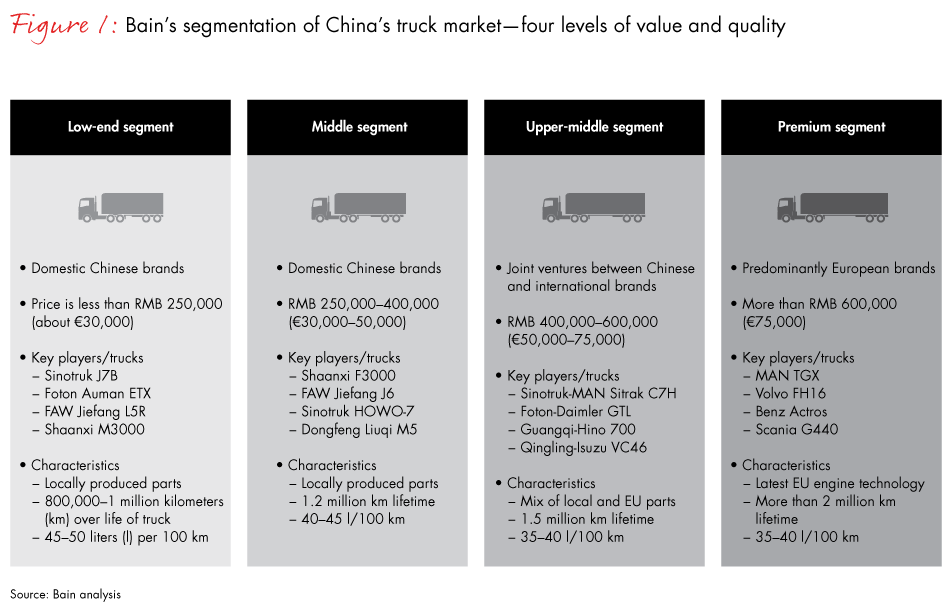
Second, China’s truck buyers are focusing more on total cost of ownership (TCO)—which may explain the intention to upgrade. Performance and quality are still the primary decision factors, with 34% of our survey respondents ranking this as the top criterion. But the relative importance of performance and quality has declined (down 19 percentage points), whereas total cost of ownership, including fuel, has become nearly as important, up 12 percentage points to 33%. Especially for truck fleets, which typically achieve high utilization rates on their vehicles, TCO advantages turn into big profit levers, creating demand for European import trucks and their lower ownership costs. As fleets continue to gain importance, we expect the focus on TCO to increase, as it has in Europe (see sidebar, “Highlights of Bain’s 2016 European Truck Study”).
A third finding is that European truck brands are perceived very positively, especially when compared with JVs and domestic brands—much more so than some in the industry might have expected. The high customer loyalty scores of European brands, which we measured using the Net Promoter System®, indicate a strong base of promoters who may be willing to pay more for a better truck, stay longer with the brand and repurchase more often, while also generating positive word of mouth and referrals. This finding points to a growing opportunity for Europe’s truck makers and would, on its own, be sufficient reason for cautious optimism among them.
Taken as a whole, our findings suggest two key growth opportunities for European truck makers.
- The premium segment will remain strong through 2022, and could grow even faster than the market as a whole. The comparatively weak customer loyalty scores of JVs imply less of a threat from them against European brands. Both facts suggest a better-than-expected environment for European import trucks in the premium segment.
- The upper-middle segment will grow faster than the total market. The increased focus on total cost of ownership, combined with the low loyalty rates of JV truck makers, creates an additional attractive opportunity in this segment.
Across both of these segments, new growth is likely to come mostly from logistics (short and long haulage as well as special haulage) rather than construction applications, which boosted sales during China’s last building boom.
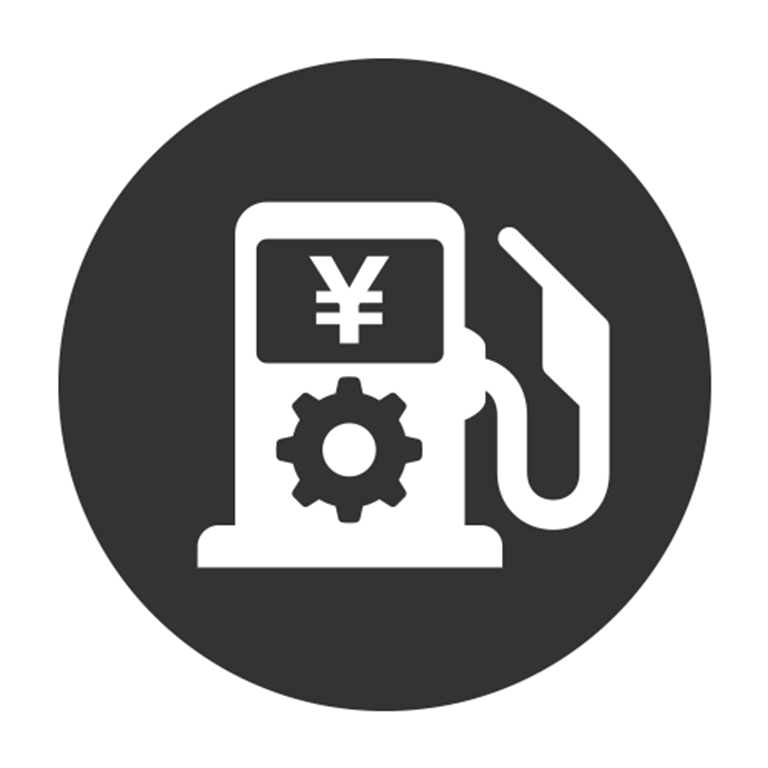
How European Truck Makers Can Succeed in China
More truck buyers in China are planning to upgrade, with the premium segment expected to double by 2022.
Capturing these opportunities won’t be easy, however. To do so, European truck makers need to address some significant challenges.
- First, they must find ways to localize their trucks in order to lower their costs and position themselves to compete with better prices.
- Second, they need to improve their sales and service networks, especially along main hauling routes.
- Finally, they should focus their sales approach on total cost of ownership, paired with better financing options, rather than on quality and performance.
Trading up
China’s heavy-duty truck market shows signs of healthy growth, especially among medium and larger fleets that are planning to expand. Across all market segments, we found that about one in four fleet managers and owners were considering upgrading to higher-value trucks, creating significant upmarket sales potential (see Figure 2). The search for better performance and quality is still the top reason for switching up, followed closely by operating costs.
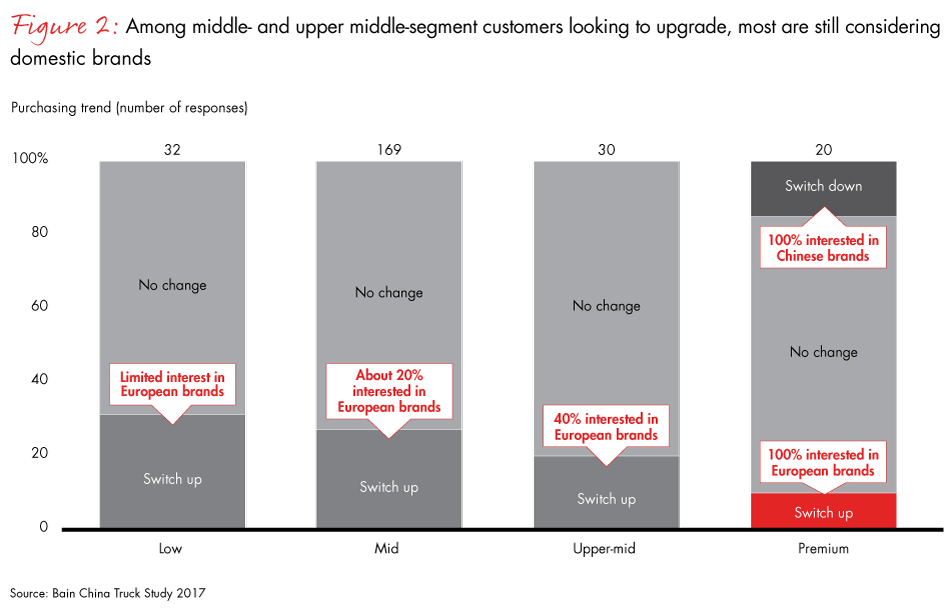
These numbers reflect the fact that China’s truck fleets are becoming increasingly professional and adopting a broader and more long-term perspective. Although European trucks have a much higher purchase price than their domestic competitors, they are typically more fuel efficient, which lowers a vehicle’s total cost of ownership. Even within the premium segment, which includes some JV vehicles from the special application category, we find customers looking to upgrade to European brands.
Key truck-purchasing criteria in China
As noted above, performance and quality are still the most important factors in the purchasing decisions of truck buyers in China, ranking first with 34% of customers. As in Europe, however, we see the relative importance of this criterion decreasing, down 19 percentage points from our last survey, conducted in 2013 (see Figure 3). Given that the previously very significant performance gaps among Chinese brands are starting to close, this decline comes as no surprise.
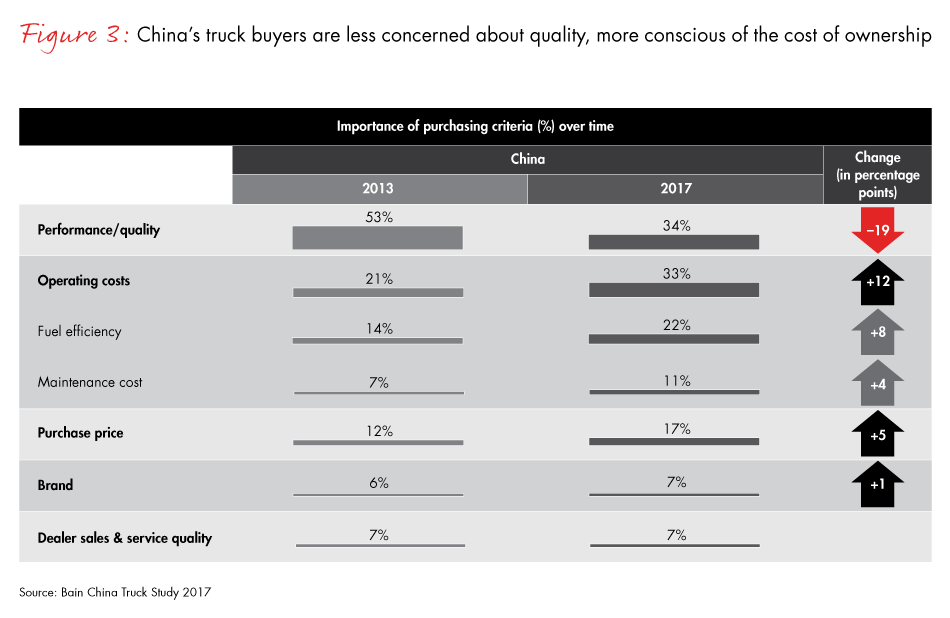
Total cost of ownership, on the other hand, has grown more influential, mainly driven by the increasing importance of fuel efficiency. TCO now rates as the second most important decision criterion with 33%, up 12 percentage points from the last survey. One explanation for this is that the standard quality of China’s domestic truck brands has reached an acceptable threshold. With basic performance a given, buyers can now look more closely at operating costs, including maintenance and fuel efficiency.
Purchase price increased in importance, but only slightly, and is still less of a concern in China than in Europe. Buyers are thinking more about the value of a truck and the total costs over its life span. This is good news for European truck makers, since the purchase price of their vehicles can be two to three times that of domestic brands in similar categories. As more (especially larger) fleets professionalize and increase in sophistication, they are looking beyond purchase price and including more TCO aspects in their business cases.
Dealer and service networks became more important to buyers of premium brands, most likely because it can be difficult to find parts and qualified mechanics for imported vehicles at acceptable prices. Our survey results suggest that these difficulties form a key argument against trading up to imported trucks. European truck makers need to continue to improve their supply chains, in some cases by building a network with a JV partner or acquiring a company with an established network.
Digital products and services are still nascent in China compared with the European market, and hence came out lower in overall importance. Among the various digital offerings, truck buyers in China were most interested in services that monitor driving behavior in real time, manage fleets or help determine predictive maintenance. But in all of these categories, interest was lower in China than we recorded in Europe.
Raymond Tsang, a partner with Bain's Industrial Goods & Services practice, explains why European players are poised to gain a competitive edge in China’s truck market.
High customer loyalty for EU brands
European truck brands earned much higher customer loyalty rankings than their JV and domestic competitors, indicating a very positive outlook. To determine each brand’s Net Promoter Score® (NPS®), our survey asked customers, “How likely is it that you would recommend this truck brand to a friend or colleague?”
As a group, the European truck makers received a Net Promoter Score of nearly 50%, indicating a strong base of customers who may be willing to pay more for better trucks, stay longer with the brand and generate positive word of mouth (see Figure 4). Interestingly enough, European brands ranked quite close to one another, all within a few NPS points.
Joint ventures earned an average Net Promoter Score of negative 5%, reflecting customers’ disappointment with JV trucks’ performance levels. Our research revealed a pattern of dissatisfied JV customers, who said that the trucks were overpriced for the level of performance and quality they delivered. The high hopes customers placed in their JV trucks—which they now find only partially fulfilled, at best—probably also played into the significantly lower-than-expected NPS.
Domestic brands fared better, with an average Net Promoter Score of 10%, boosted by strong and improving scores from Foton and Shaanxi. Positive scores, however, were offset by many detractors in this category—that is, customers who would not recommend their brands to others.
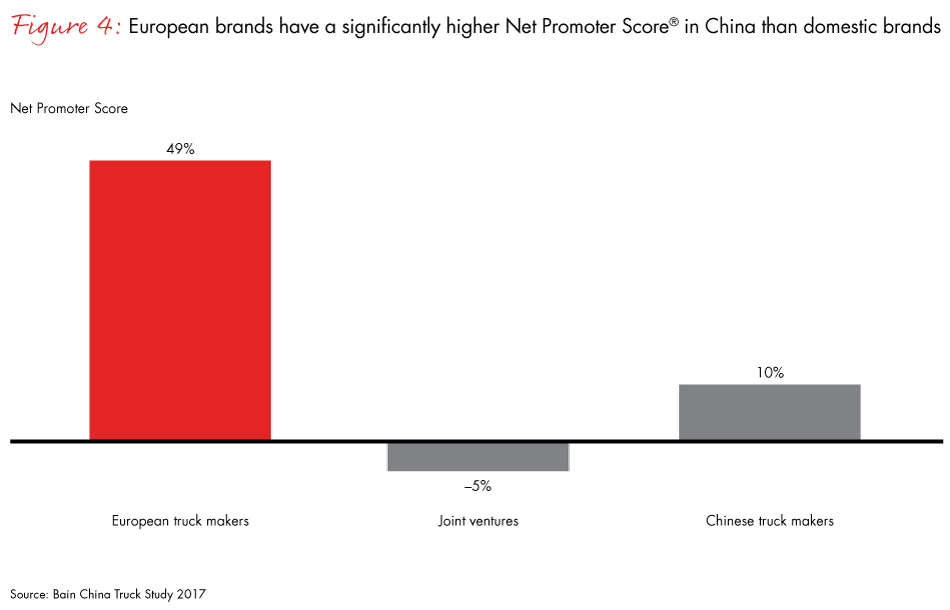
Seizing the moment
The new opportunities in China’s truck market may come as a surprise to some European executives. After all, the consensus had been that the days were numbered for premium European imports, and that JVs would dominate the upper-middle market and even large parts of the premium segment with their hybrid trucks, made from core European parts plus key additions from Chinese partners.
However, the relatively weak Net Promoter Scores of JVs suggest they may pose less of a threat to European import brands, and as China’s truck buyers focus on total cost of ownership and trading up to the premium segment, two compelling opportunities emerge for European truck makers.
- Premium segment. Expected to grow steadily through 2022, with less competitive pressure from JVs than expected, this segment is well suited for European trucks.
- Upper-middle segment. Filled with customers disappointed with JV trucks and looking for higher quality, better performance and more economical ownership costs, this segment could also provide an attractive field for European brands.
To capitalize on these opportunities, Europe’s truck makers have their work cut out for them in three critical areas.
-
Localize to reduce costs. European truck makers should look for ways to lower their costs while preserving the key components that deliver superior TCO. Possible approaches include:
- continue to import trucks from Europe, but with significant cost measures on all components not relevant to TCO;
- source and assemble in other low-cost Asian markets, such as India; and
- localize and assemble in China together with strong local truck makers or using new opportunities in the ASEAN freetrade zone or new types of joint ventures in China—for example, with industrial players that bring specific skills and manufacturing capabilities (such as a maker of construction equipment) but which lack a legacy truck chassis or drivetrain elements that they might force into a JV truck.
- Improve sales and service networks. Building a more comprehensive network requires a balancing act: Truck makers need to invest in their sales and service infrastructure to sell more vehicles, but those vehicles need to be on the road to justify the investment in larger networks. Europeans should consider forming partnerships with truck repair chains and other specialists along main hauling routes, which can help expand the reach of their sales and service efforts.
- Refocus sales approach on TCO. Performance and quality are still important, but as more decision makers consider ownership costs, European truck makers’ sales and marketing efforts should address this opportunity. A range of improved financing options could complement these efforts and put European trucks’ purchase price within reach of more buyers.
Europe’s truck makers have reasons for renewed optimism, given the rising ambitions and expectations of China’s truck buyers. Seizing the opportunity will require strategic decisions, investment in new capabilities and steady focus. While the quality of China’s domestic brands continues to improve, for the time being the Europeans’ keenest competitors in the premium segment, and potentially also the upper-middle segment, are other European truck makers.
Highlights of Bain’s 2016 European Truck Study
Bain’s China Truck Study of 2017 complements our 2016 research on truck buyers and owners in Europe. Among the key findings of that research:
-
The hard factors of ownership such as new sales price, fuel consumption and performance, which we called “value for money” in our survey, remain most important to European buyers, making up nearly three-fourths of the purchase decision.
- Total cost of ownership (TCO) accounted for a full third of importance in purchasing decisions, followed by new sales price with 22% and truck performance with 17%.
- The importance of TCO grows with fleet size, starting with 31% for fleets up to 10 trucks and rising to 39% for fleets larger than 50 trucks. In contrast, new sales price loses importance as fleets become larger.
- The relationship with the manufacturer, which makes up about 18% of the purchase decision, increased in importance since our 2006 study.
- The importance of brand image declined across countries.
- The performance gap has narrowed between premium and low-cost truck makers in Europe, raising the stakes on other differentiators.
- Digital services are becoming increasingly important as differentiators, with buyers most interested in services that increase uptime and raise efficiency (driver monitoring, predictive maintenance) and less interested in infotainment or other nonessential services.
For more on this work, see “What Matters Most in Europe’s Truck Market.”
1 Bain’s China Truck Study 2017 included in-depth interviews with more than 350 stakeholders across all relevant provinces and customer segments. The study complements our 2016 research on the European market, reported on in “What Matters Most in Europe’s Truck Market.”
Jörg Gnamm and Eric Zayer are partners with Bain & Company in Munich. Ray Tsang and Bruno Zhao are partners in Bain’s Shanghai office. All four work with Bain’s Global Automotive practice.
Net Promoter System®, Net Promoter Score® and NPS® are registered trademarks of Bain & Company, Inc., Fred Reichheld and Satmetrix Systems, Inc.



